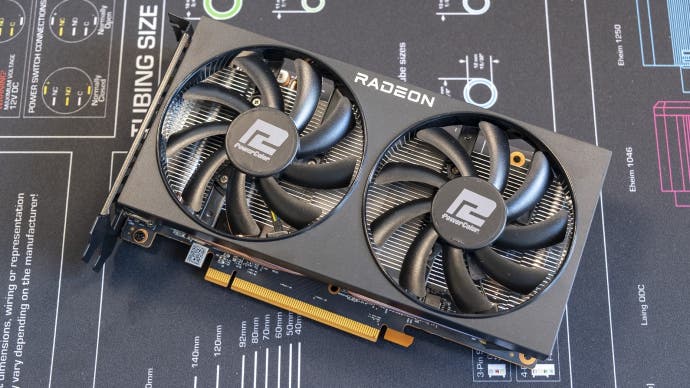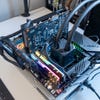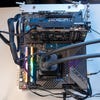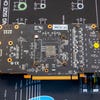AMD Radeon RX 6600 review: damp squib
The RTX 3060 ostensibly costs the same and performs better.
A new graphics card has arrived: the $329/£299 RX 6600, little brother to the RX 6600 XT that launched back in August. It's intended to compete against Nvidia's RTX 3060, which also has a $329 RRP, as well as older graphics cards like Nvidia's RTX 2060, 2060 Super and 2070.
The pitch here is pretty simple: it's faster than those older cards, competitive with the RTX 3060, and its position at the bottom of AMD's current GPU stack should mean that it can be made in large quantities. In fact, the pitch is so simple that our press briefing for the GPU was extremely rapid - a few slides of specs, expected performance versus the RTX 2060 and RX 5600 XT, a few shots of partner models and then the call for questions. The briefing wrapped up before 15 minutes had expired, a relative instant compared to the hour-long calls we normally expect - so is the RX 6600 that simple, or is there more here than meets the eye?
To find out, we've been testing the RX 6600 against its closest competitors in a range of games for the past few days. We'll get into the results on the next page, but for now let's set some expectations based on the card's specifications - and take a look at the particular model that we were sent for testing, as there is no AMD reference design for sale this time around. As usual, we'll assume that the card will be available at AMD's stated RRP, just to give us a basis for comparison that is a little less variable than the ebb and flow of price inflation across the globe.
Looking at the specs, the RX 6600 is actually very similar to the RX 6600 XT we looked at just a few months ago. The major differences come in terms of compute - we have 28 compute units compared to the 6600 XT's 32 compute units - and in clock speed, with the game clock sitting at 2044MHz compared to 2359MHz for the 6600 XT. The memory subsystem appears the same, with 8GB of GDDR6 memory and a 128-bit interface augmented with 32MB of Infinity Cache. (Memory was in many ways the weakness of the RX 6600 XT, so this suggests the 6600 might posses a more balanced design.) Power usage is a meagre 132W, just a whisker away from the RX 5500 XT's 130W, an impressive figure given the higher clock speed and more complicated design offered by the newest Big (medium? small?) Navi card. With the 6600 XT possessing 14 percent more CUs, a 15 percent higher clock speed and a 21 percent higher power draw, we'd expect the XT model to offer around 15-20 percent better performance overall.
| AMD GPU Specs | CUs | Game Clock | VRAM | Mem Interface | TDP | Price |
|---|---|---|---|---|---|---|
| RX 6900 XT | 80 | 2015MHz | 16GB GDDR6 | 256-bit + 128MB IC | 300W | $999 |
| RX 6800 XT | 72 | 2015MHz | 16GB GDDR6 | 256-bit + 128MB IC | 300W | $649 |
| RX 6800 | 60 | 1815MHz | 16GB GDDR6 | 256-bit + 128MB IC | 250W | $579 |
| RX 6700 XT | 40 | 2424MHz | 12GB GDDR6 | 192-bit + 96MB IC | 230W | $479 |
| RX 6600 XT | 32 | 2359MHz | 8GB GDDR6 | 128-bit + 32MB IC | 160W | $379 |
| RX 6600 | 28 | 2044MHz | 8GB GDDR6 | 128-bit + 32MB IC | 132W | $329 |
| RX 5700 XT | 40 | 1755MHz | 8GB GDDR6 | 256-bit | 225W | $399 |
| RX 5700 | 36 | 1625MHz | 8GB GDDR6 | 256-bit | 180W | $349 |
| RX 5600 XT | 36 | 1375MHz | 6GB GDDR6 | 192-bit | 150W | $279 |
| RX 5500 XT | 22 | 1717MHz | 8GB GDDR6 | 128-bit | 130W | $199 |
Of course, manufacturers are able to deviate from that formula with their own designs, but the PowerColor Fighter card we were sent looks like an entry-level design that should hit the stated $329/£299 price-point. This two-slot card is quite compact, at 205x100x40mm, with dual 90mm fans, three direct touch heatpipes and an aluminium fin-stack. The card's fans remain off until the card reaches 60°C, and in my testing the card remained cool and quiet, maxing out around 70°C during full load. The card has one HDMI 2.1 port and three DisplayPort 1.4 ports, making this one of the cheapest ways to add an HDMI 2.1 port - something that might be useful for a media PC hooked up to a 4K 120Hz display, although we don't expect to see excellent 4K gaming performance from an entry-level card, even in 2021. One eight-pin auxiliary power input is required, a feature shared among most if not all RX 6600 implementations thanks to that 132W TDP. Overall, it's a simple but seemingly effective design.
Our test rig has remained the same, save for one minor change. We use a Core i9 10900K system as this provided the best out-and-out gaming performance when current-gen GPUs launched back in 2020, backed with an Asus Maximus 13 Hero Z590 motherboard, dual-channel G.Skill Trident-Z Royal DDR4-3600 CL16 memory and a 2TB Samsung 970 Evo Plus NVMe drive from Box. To keep our CPU performance constant, we've locked it to 5GHz on all cores and kept it cool with a 240mm Eisbaer Aurora liquid cooler. The new component is our power supply; our 850W Gamer Storm Castle has been replaced by what we hope is a more reliable 1000W Corsair RM1000x unit supplied by Infinite Computing.
Now that you're familiar with the premise, the hardware and our testing apparatus, let's get onto the results!
AMD Radeon RX 6600 analysis
- Introduction and hardware analysis [This Page]
- Doom Eternal, Control, Borderlands 3, Shadow of the Tomb Raider - Game Benchmarks Part 1
- Death Stranding, Far Cry 5, Hitman 2, Assassin's Creed Odyssey - Game Benchmarks Part 2
- Metro Exodus, Dirt Rally 2, Assassin's Creed Unity - Game Benchmarks Part 3
- Control, Metro Exodus, Battlefield 5 - RT game benchmarks
- AMD Radeon RX 6600 - the Digital Foundry verdict


















